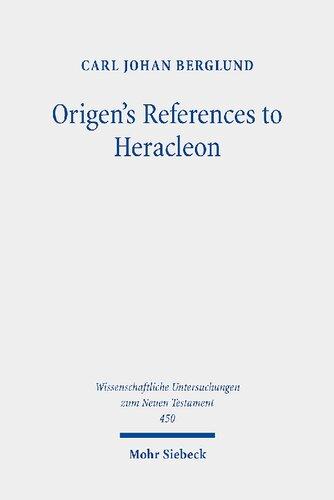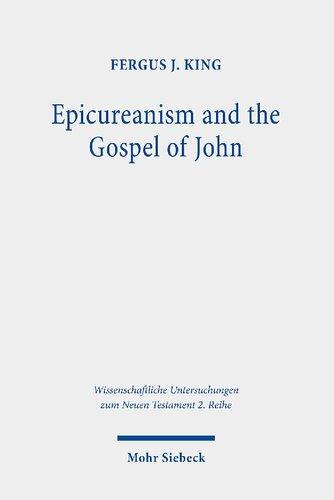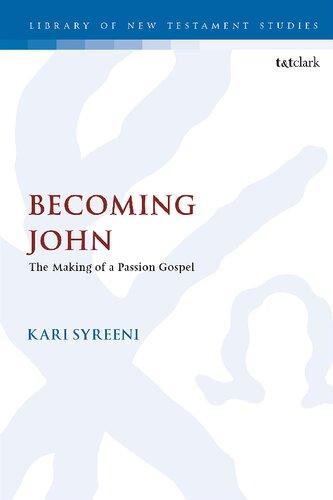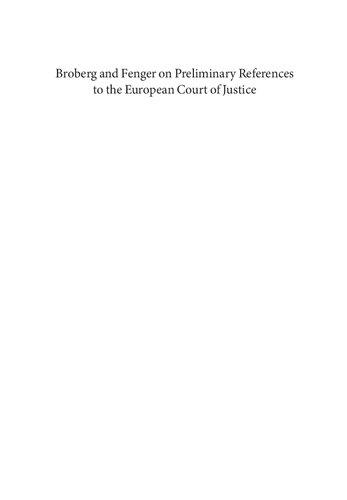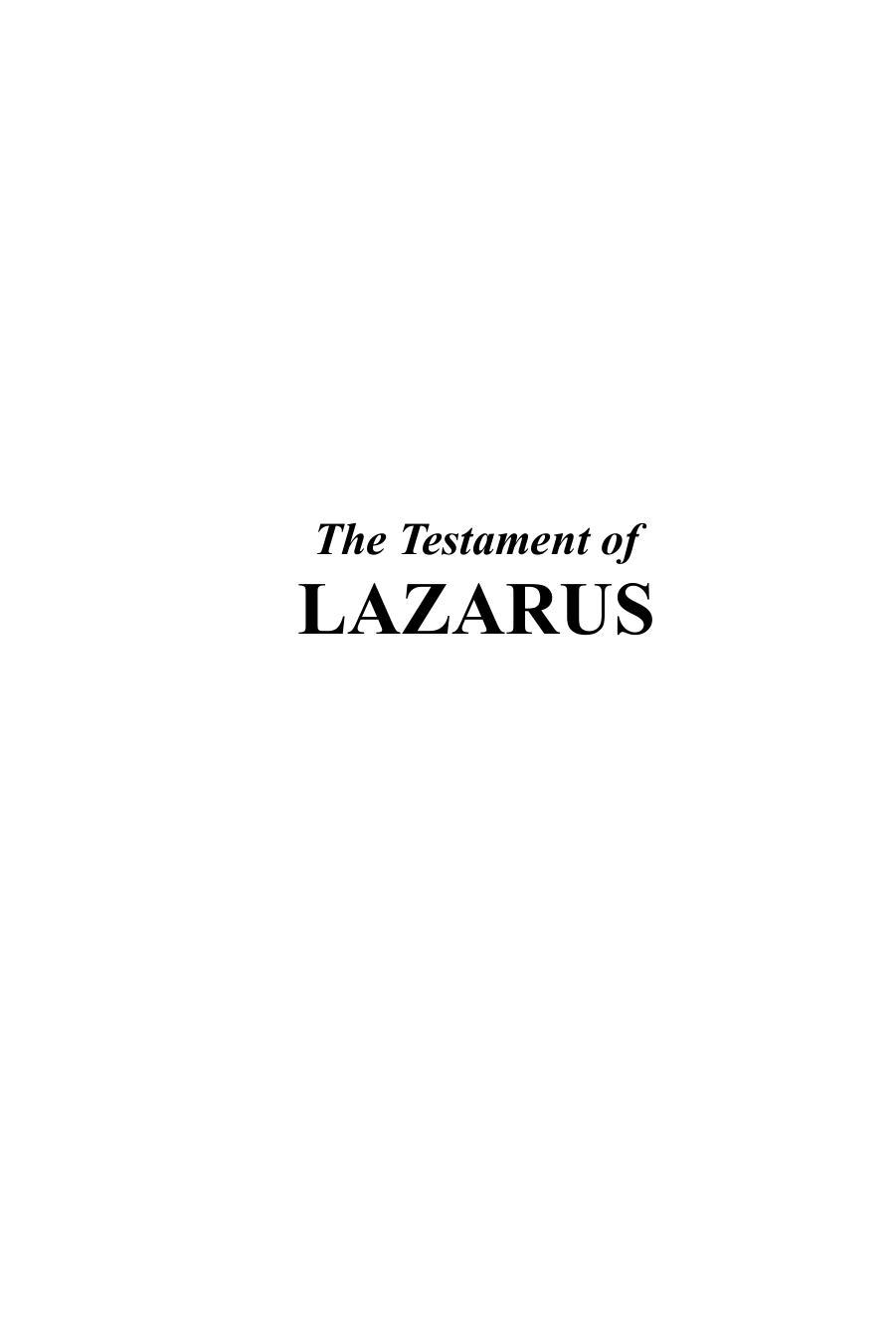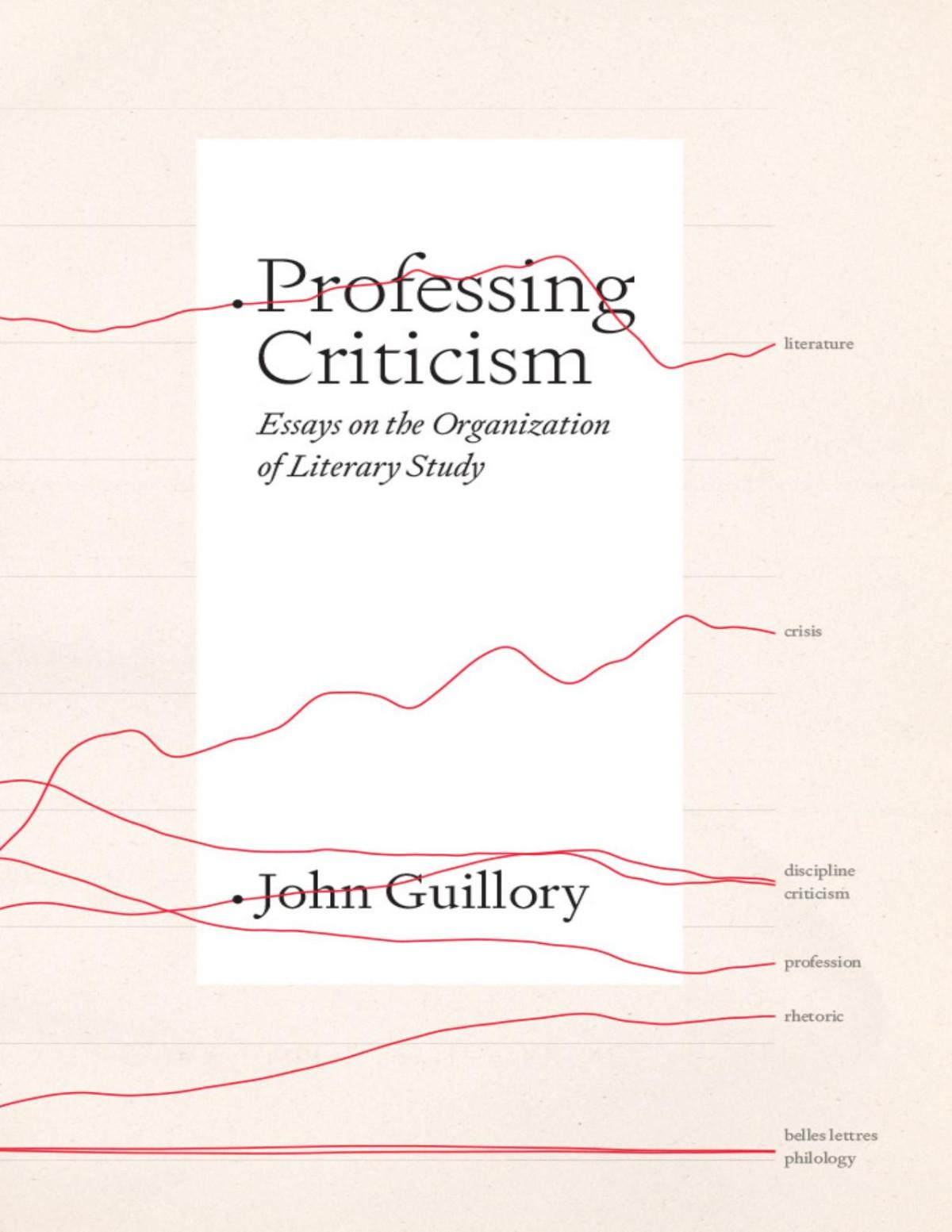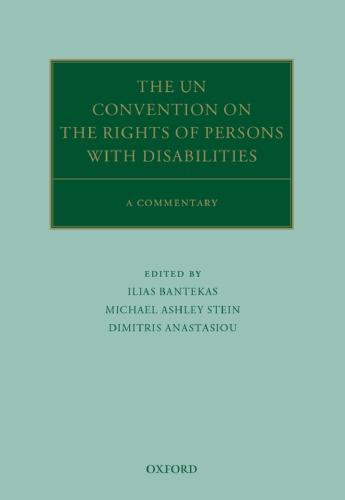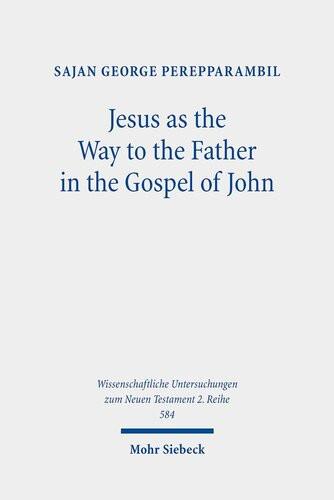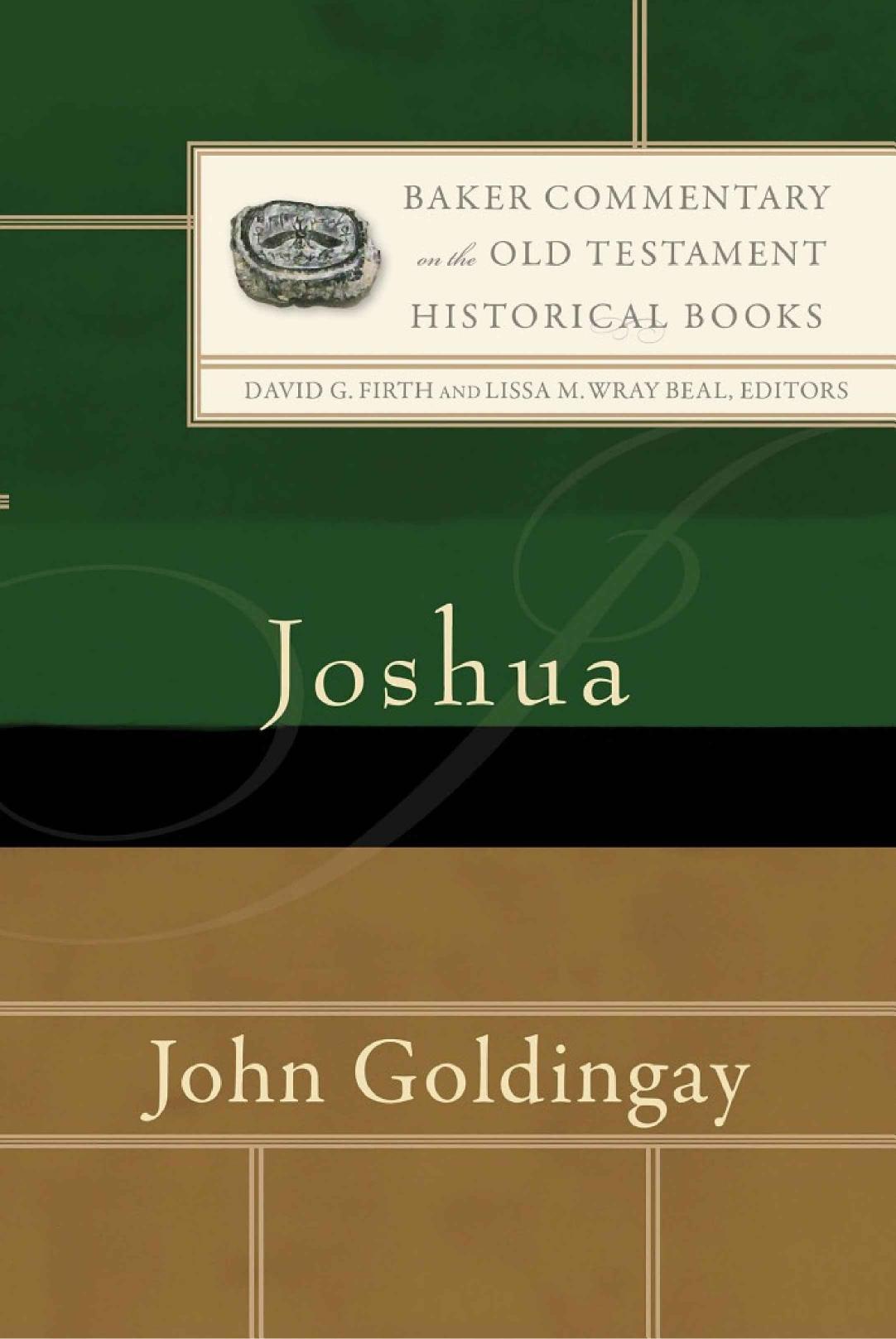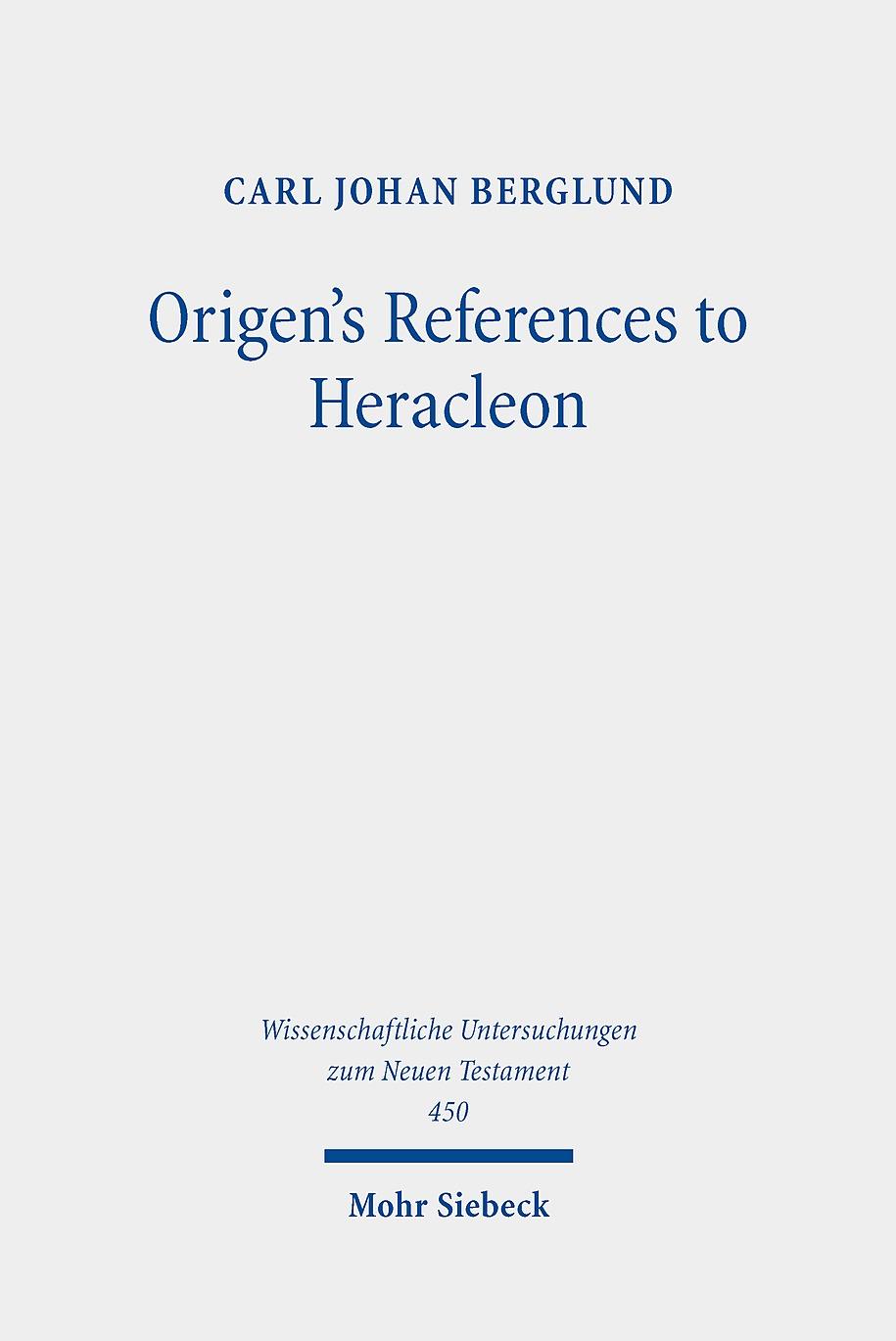Origen’s References to Heracleon
A Quotation-Analytical Study of the Earliest Known Commentary on the Gospel of John
Mohr Siebeck
Carl Johan Berglund, born 1973; 1997 Master of Science in Engineering, KTH, Stockholm; 2007 Bachelor of Theology, Stockholm School of Theology; 2008 pastor, Swedish Mission Covenant Church (now Uniting Church in Sweden); 2019 PhD (Faculty of Theology) in New Testament Exegesis, Uppsala University; since 2019 Director of Studies at University College Stockholm (Stockholm School of Theology). orcid.org/0000-0002-2203-7977
ISBN 978-3-16-159221-8 / eISBN 978-3-16-159222-5
DOI 10.1628/978-3-16-159222-5
ISSN 0512-1604 / eISSN 2568-7476 (Wissenschaftliche Untersuchungen zum Neuen Testament)
The Deutsche Nationalbibliothek lists this publication in the Deutsche Nationalbibliographie; detailed bibliographic data are available at http://dnb.dnb.de
© 2020 Mohr Siebeck Tübingen, Germany. www.mohrsiebeck.com
This book may not be reproduced, in whole or in part, in any form (beyond that permitted by copyright law) without the publisher’s written permission. This applies particularly to reproductions, translations and storage and processing in electronic systems.
The book was printed on non-aging paper by Gulde Druck in Tübingen, and bound by Buchbinderei Spinner in Ottersweier.
Printed in Germany.
Preface
Preface
This monograph is a revised version of my doctoral dissertation in New Testament Exegesis, which was defended at Uppsala University in June of 2019. Since I began working on Origen’s references to Heracleon in 2012, I have had the pleasure to interact with fellow scholars in a number of settings, some of which have led to the publication of earlier versions of certain of the arguments in the book. My take on Greco-Roman education and learned culture was well received at a conference in Göttingen, Germany, in 2015, and a number of the points made in chapter 2 are previously made in my paper in the conference volume.1 The difficulties of evaluating ancient Greek quotations were discussed in Leuven, Belgium, in 2015, and the beginning of chapter 3 is a reworked version of my essay in the conference volume.2 My methodology for discerning verbatim quotations from less faithful renderings, which is discussed in the rest of chapter 3, was presented at the Origeniana Duodecima conference in Jerusalem in 2017, and was later published in the conference proceedings.3 Likewise, my analysis of Heracleon’s interpretation of the healing of a son of a royal official in John 4:46–54 was presented at a conference in Örebro, Sweden, in 2018, and has since been published in a conference volume.4
Many people have generously contributed to the completion of this work. My academic supervisors, James A. Kelhoffer, Anders Ekenberg, and Peter Martens, have gently and expertly guided me toward the more fruitful areas of my research. Ronald E. Heine has been a generous mentor with a seeming-
1 Carl Johan Berglund, “Interpreting Readers: The Role of Greco-Roman Education in Early Interpretation of New Testament Writings,” in Scriptural Interpretation at the Interface between Education and Religion, ed. Florian Wilk, TBN 22 (Leiden: Brill, 2018), 204–47
2 Carl Johan Berglund, “Evaluating Quotations in Ancient Greek Literature: The Case of Heracleon’s Hypomnēmata,” in Shadowy Characters and Fragmentary Evidence: The Search for Early Christian Groups and Movements, eds. Joseph Verheyden, Tobias Nicklas, and Elisabeth Hernitscheck, WUNT 388 (Tübingen: Mohr Siebeck, 2017), 201–31
3 Carl Johan Berglund, “Discerning Quotations from Heracleon in Origen’s Commentary on the Gospel of John,” in Origeniana Duodecima, eds. Brouria Bitton-Ashkelony and Rita Corstjens, BETL 302 (Leuven: Peeters, 2019), 489 –503
4 Carl Johan Berglund, “How ’Valentinian’ Was Heracleon’s Reading of the Healing of the Son of a Royal Official?,” in Healing and Exorcism in Second Temple Judaism and Early Christianity, eds. Mikael Tellbe and Tommy Wasserman, WUNT II/511 (Tübingen: Mohr Siebeck, 2019), 219–39
ly inexhaustible supply of experience of scholarship on Origen. Marianne Wifstrand Schiebe has been exceedingly helpful, not least in her tireless efforts in scrutinizing my translations from ancient Greek. Karl Olav Sandnes has been a recurrent source of joy and new perspectives on my work. Harold W. Attridge, Tobias Nicklas, Joseph Verheyden, and Ismo Dunderberg have been helpfully encouraging. David Konstan has been a cordial critic. Simeon Burke has been a friend and a critical reader. Martin Wessbrandt has been a stimulating conversation partner. Hans Engdahl has contributed with another perspective on Origen. And my fellow doctoral students Bim O’Reilly, Daniel Gustafsson, Adam Sabir, Michael Öberg, and Petter Spjut have been good companions on the long journey from project description to final draft.
The writing of a scholarly monograph would be impossible without loving support and encouragement from those closest to one’s heart. Fortunately, I have been generously supplied, in innumerous forms, by Linda, the love of my life, and by our two wonderful sons Albin and Einar. May you both grow up to question the world with all your minds, love your neighbors with all your strengths, and trust the Lord with all your hearts!
Vällingby, June 2020
Carl Johan Berglund
IV. Quotations in Clement of Alexandria ............................................
Quotations in Eusebius of Caesarea ..............................................
Chapter 4: Creators and Creations ......................................................................
A. Passage 1: The Agency of Creation (John 1:3a)
B. Passage 2: Spiritual Humans and Spiritual Life (John 1:3b–4) .............
Chapter 5: The Testimony of John the Baptist ....................................................
A. Passage 3: The Explanation of the Only-Begotten (John 1:16–18) .......
B. Passage 4: A Prophet Who Is Not the Prophet (John 1:21b) ................
C. Passage 5 A: The Word, the Voice, and the Sound (John 1:23) ............
D. Passage 5 B: What Is Around John Is Not John Himself (John 1:21)
E. Passage 5 C: The Investigating Priests and Levites (John 1:19) ............
F. Passages 6–7: John’s Reason for Baptizing (John 1:24–27) .................. 149
G. Passage 8: Christ’s Physical Presence (John 1:26–27) ............................ 153
H. Passage 9: The Location of the Questioning (John 1:28) 159
I. Passage 10: The Less-than-Perfect Lamb of God (John 1:29) .............. 160
Chapter 6: Passover in Jerusalem ........................................................................ 165
A. Passages 11–12: Visiting Capernaum (John 2:12–13a) 165
B. Passages 13–14: Merchants in the Temple Court (John 2:13b–17) ........ 171
C. Passages 15–16: Three Days and Forty-Six Years (John 2:18–20) ......... 181
Chapter 7: Meeting at the Well 187
A. Passage 17: A Temporary Life (John 4:13–15)......................................... 187
B. Passage 18: The True Husband (John 4:16–18) ...................................... 196
C. Passage 19: The Right Place for Worship (John 4:19–20) 201
D. Passage 20: On False Worship (John 4:21)............................................ 204
E. Passage 21: Knowing Whom You Worship (John 4:22) .......................208
F. Passage 22: Worshiping in Spirit and Truth (John 4:23) ...................... 214
G. Passage 23: The Lost Members of the Household (John 4:23b) 219
H. Passage 24: In What Way Is God “Spirit”? (John 4:24) ........................ 221
I. Passage 25: The One Who Knows Everything (John 4:25) .................. 224
J. Passage 26: Christ Reveals Himself (John 4:26–27) .............................. 225
K. Passage 27: The Abandoned Water Jar (John 4:28–30) 227
Chapter 8: The Disciples at Sychar ....................................................................... 231
A. Passages 28–31: The Spiritual Food of Jesus (John 4:31–34) .................. 231
B. Passages 32–36: The Imminent Harvest (John 4:35–38) 238
C. Passages 37–39: The Samaritan Revival (John 4:39–42) ....................... 254
Chapter 9: The Healing of a Son ..........................................................................
A. Passage 40 A: The Royal Official (John 4:46)........................................
B. Passage 40 B: The Human Condition (John 4:47–50) ..........................
C. Passage 40 C: The House of the Royal Official (John 4:51–53) ............ 275
Chapter 10: Death and the Devil .........................................................................
A. Passages 41–42: Hope of Immortality (John 8:21–22) ...........................
B. Passages 43–46: Children of the Devil (John 8:43–44a) .......................
C. Passage 47: Standing in the Truth (John 8:44b)
D. Passage 48: The Last Judge (John 8:50) ..................................................
Figure 1. Extent of adaptation vs. mode of attribution. ....................................... 7
Figure 2. The structure of Origen’s Commentary. .............................................. 13
Chapter 1
Introduction
Chapter 1: Introduction
Chapter 1: Introduction
In the second century CE, a fascinating transition in the reception of early Christian literature occurred. The earliest generations had been engaged in rewriting the written material they had inherited into new compositions, the way Luke is generally believed to have rewritten Mark, writers of early Christian letters to have copied Paul, and authors of apocryphal Acts to have built on earlier Christian narratives. By contrast, a new generation retained previous Christian writings as they were, and placed their own reflections in commentaries (hypomnēmata), a type of secondary literature in which the added material is clearly separated from the original text, and which thereby presents the original text as valuable, important, and authoritative. This transition contributed to establishing the fourfold Gospel and the Pauline letters as authoritative writings comparable to the Old Testament, and is therefore formative for the emerging New Testament.
The earliest known witnesses to this transition, the hypomnēmata on the Gospels written by the second-century Christian author Heracleon, are –unfortunately enough – only extant in the form of references made by two later authors: two in the works of Clement of Alexandria (ca. 150–215 CE) and four dozen by Origen of Alexandria (ca. 185–254 CE).1 The Greek word ὑπομνήματα can be used to refer not only to learned commentaries, but also to official records, personal notes, and physical means of remembrance, which means that we do not know the actual genre of Heracleon’s writing. Since all we have is a collection of short excerpts, we know neither if it had any other title, nor the extent or format of the work.2
1 The title of Heracleon’s writing is taken from the description in Origen, Comm. Jo. 6 15/92 (SC 157, 196 42): ἐν οἷς καταλέλοιπεν ὑπομνήμασιν (“in the hypomnēmata he [Heracleon] has left behind”). References to Origen’s Commentary on the Gospel of John will be given with book number, chapter number, and paragraph number. Chapter and paragraph numbers will be separated with a slash rather than a dot, to signify that the paragraph numbering is continuous throughout each book and not subordinated to the chapter numbering. When a quotation is presented, a reference to an edition in the Sources Chrétiennes series will also be given. Unless otherwise indicated, translations from Greek will be my own.
2 Heracleon’s activity is impossible to date with any more precision than to the second half of the second century. Alan England Brooke, The Fragments of Heracleon, TS I.4 (Cambridge: Cambridge University Press, 1891), 31–34, argues for a date around 170; Eugène de Faye, Gnostiques et gnosticisme: Étude critique des documents du gnosticisme chré-
Ancient authors mentioning Heracleon generally describe him as a heretic teacher connected to Valentinus (ca. 100–175 CE), who was one of several mid-second-century candidates for leadership of the Christian community in Rome, but left the city after failing to gain sufficient support.3 Irenaeus of Lyons (ca. 130–202 CE) mentions Heracleon briefly as a proponent of Valentinus’s doctrines, especially the belief in a heavenly Fullness (πλήρωμα) inhabited by no less than thirty divine eons (αἰῶνες) that were emanated from the Father.4 Tertullian of Carthage (ca. 160–225 CE) presents Heracleon as a follower of another teacher, Ptolemy (second century CE), who allegedly had departed from Valentinus by viewing the eons as deities in their own right rather than as aspects of the one God.5 The author of the Elenchos, often identified with Hippolytus of Rome (ca. 170–235 CE),6 presents Heracleon as a
tien aux IIe et IIIe siècles, 2nd ed. (Paris: Paul Geuthner, 1925), 77, suggests 155–180; Elaine H. Pagels, The Johannine Gospel in Gnostic Exegesis: Heracleon’s Commentary on John, SBLMS 17 (Nashville: Abingdon, 1973), 16, proposes 160–180; Timothy James Pettipiece, “The Nature of ‘True Worship’: Anti-Jewish and Anti-Gentile Polemic in Heracleon (Fragments 20–24),” in Colloque International “L’Évangile Selon Thomas et les Textes de Nag Hammadi,” eds. Louis Painchaud and Paul-Hubert Poirier, Bibliothèque copte de Nag Hammadi 8 (Leuven: Peeters, 2007), 377–94, here 378, argues for 150–175; Agnès Bastit, “Forme et méthode du Commentaire sur Jean d’Héracléon,” Adamantius 15 (2009): 150–76, here 151, proposes 160–170; Einar Thomassen, “Heracleon,” in The Legacy of John: SecondCentury Reception of the Fourth Gospel, ed. Tuomas Rasimus, NovTSup 132 (Leiden: Brill, 2010), 173–210, here 174, claims, on the basis of his reception by Irenaeus, that he must have been a well-known figure by 180. Alastair H. B. Logan, “The Johannine Literature and the Gnostics,” in The Oxford Handbook of Johannine Studies, eds. Judith M. Lieu and Martinus C. de Boer (Oxford: Oxford University Press, 2018), 171–85, here 183, points to the late 170s or 180s.
3 Tertullian, Val. 4 1. Heracleon’s double association to Rome (where Valentinus taught) and Alexandria (where Origen encountered his hypomnēmata) has caused some scholars, including Birger A. Pearson, Ancient Gnosticism: Traditions and Literature (Minneapolis: Fortress Press, 2007), 161–62, to speculate that he was “an Alexandrian who spent some time in Rome as a Valentinian teacher and then returned to Alexandria.”
4 Irenaeus, Haer. 2 4 1 Michael Kaler and Marie-Pierre Bussières, “Was Heracleon a Valentinian? A New Look at Old Sources,” HTR 99 3 (2006): 275–89, here 277, are entirely correct that Irenaeus bases the link from Heracleon and Ptolemy to Valentinus on their views, and “does not directly state that Heracleon studied with or followed Valentinus.” However, Irenaeus clearly assumes that the reader knows Heracleon and Ptolemy as affiliated with Valentinus.
5 Tertullian, Val 4 (SC 280, 86 11–16): Eam postmodum Ptolemaeus intrauit, nominibus et numeris aenonum distinctis in personales substantias, sed extra deum determinatas, quas Valentinus in ipsa summa diuinitatis ut sensus et affectus, motus incluserat. Deduxit et Heracleon inde tramites quosdam et Secundus et magus Marcus.
6 For an overview of the debate concerning the authorship of the Elenchos, which is also known as Philosophumena or Refutatio omnium haeresium, see Enrico Norelli, “Construire l’opposition entre orthodoxie et hérésie à Rome, au IIIe siècle,” in Des évêques, des écoles et des hérétiques: Actes du Colloque international sur la Réfutation de toutes les hérésies, Ge-
“Valentinian” follower from the Italian peninsula who held that the human Jesus received the divine Word from his heavenly mother Sophia at his baptism. 7 Clement presents Heracleon as “the most notable of Valentinus’s school” and sets forth two separate instances where Heracleon comments on material that seems to stem from the Synoptic Gospels.8 And most importantly, Origen presents Heracleon as a personal acquaintance of Valentinus, and interacts with his interpretations of the Fourth Gospel on four dozen occasions.9
This common way of presenting one’s adversaries as links in a genealogical chain through which certain “heresies” have been inherited, ultimately from the magician Simon of Acts 8:9–24, is regularly used by early Christian heresiologists in order to persuade their readers to reject these teachers before even considering their words and opinions.10 Despite this insight, previous
nève, 13–14 juin 2008, eds. Gabriella Aragione and Enrico Norelli (Prahins: Editions du Zèbre, 2011), 233–55; Manlio Simonetti, “Per un profilo dell’autore dell’Elenchos,” in Des évêques, des écoles et des hérétiques: Actes du Colloque international sur la Réfutation de toutes les hérésies, Genève, 13–14 juin 2008, eds. Gabriella Aragione and Enrico Norelli (Prahins: Editions du Zèbre, 2011), 257–73; Allen Brent, “The Elenchos and the Identification of Christian Communities in Second – Early Third Century Rome,” in Des évêques, des écoles et des hérétiques: Actes du Colloque international sur la Réfutation de toutes les hérésies, Genève, 13–14 juin 2008, eds. Gabriella Aragione and Enrico Norelli (Prahins: Editions du Zèbre, 2011), 275–314. For arguments for the traditional attribution, see Miroslav Marcovich, “Introduction,” in Refutatio Omnium Haeresium, PTS 25 (Berlin: de Gruyter, 1986), 1–51, here 8–17.
7 Elenchos (also known as Hippolytus, Haer.) 6.p.4, 6.29.1, 6.35.6.
8 Clement, Strom. 4.9/71–72; Ecl. 25.1.
9 Heracleon is also mentioned in Theodoretus (ca. 393–466), Haereticarum fabularum compendium 1 8, and in Photius (ca 810–893 CE), Ep. 134 Thomassen, “Heracleon,” 173, remarks: “That Heracleon was a ’Valentinian’ is thus a point on which all our sources agree.” He does admit, however, that some of these sources seem to know no more about Heracleon than his name. Pier Franco Beatrice, “Greek Philosophy and Gnostic Soteriology in Heracleon’s ‘Hypomnemata,’” EC 3 2 (2012): 188–214, here 189, remarks that “these authors supply very little information about Heracleon, his work and thought, and what they do tell us is not always consistent.” de Faye, Gnostiques et gnosticisme, 76, goes so far as to state that the information given by most sources is so meager that one learns nothing from them.
10 Bentley Layton, “The Significance of Basilides in Ancient Christian Thought,” Representations 28 (1989): 135–51, here 136, characterizes the effects of this rhetoric as replacing original ideas with trivialized substitutes, concealing their potential relevance, and causing them to be forgotten. Einar Thomassen, The Spiritual Seed: The Church of the “Valentinians,” Nag Hammadi and Manichaean Studies 60 (Leiden: Brill, 2006), 19–20, argues that Irenaeus’s presentation of the “Valentinians” is based on a combination of different sources including the first known heresy catalogue, the Catalogue against all the Heresies quoted in Justin Martyr, 1 Apol. 26.2–5. John Behr, Irenaeus of Lyons: Identifying Christianity, Christian Theology in Context (Oxford: Oxford University Press, 2013), 83–85, describes Irenaeus’s genealogy from Simon Magus to Tatian, suggests that the practice goes
scholarship on Heracleon has generally taken these presentations at face value and presumed that Heracleon’s interpretations are determined by a set of controversial doctrines conforming to either “Valentinianism” or “Gnosticism.” Where no such doctrines are visible in the extant material, they have nonetheless been presumed to be present, as a hidden agenda behind the exegesis in Heracleon’s hypomnēmata. In opposition to this practice, Hermann Langerbeck and Ansgar Wucherpfennig have argued that Origen in his responses to Heracleon presumes later “Valentinian” ideas that are unattested in Heracleon’s own writing.11
In addition, previous scholars have generally – typically after a brief lamentation of the fact that Heracleon’s comments are available only by the mediation of Clement and Origen – presumed that almost every statement they attribute to this allegedly “Valentinian” predecessor is a faithful rendering of Heracleon’s views, words, and interpretive practices.12 This has been
back to Polycarp, and notes that the genealogy has almost no point of contact with Valentinus and his disciples. Geoffrey S. Smith, Guilt by Association: Heresy Catalogues in Early Christianity (Oxford: Oxford University Press, 2014), 4–5, 49–57, 131–34, traces a common format – ordering allegedly false teachers in chronological order, frequently pre senting them as disciples of previous teachers, to give the impression of an unbroken chain of heretic transmission going back to Simon Magus – back to Justin’s Catalogue. A complementary approach, in which “heretic” teachers were presented as having imported their ideas from Greek philosophy, is described by Winrich Alfried Löhr, “Christian Gnostics and Greek Philosophy in the Second Century,” EC 3.3 (2012): 349–77, here 350.
11 Hermann Langerbeck, “Die Anthropologie der alexandrinischen Gnosis: Interpretationen zu den Fragmenten des Basilides und Valentinus und ihrer Schulen bei Clemens von Alexandrien und Origenes,” in Aufsätze zur Gnosis, ed. Hermann Dörries, Abhandlungen der Akademie der Wissenschaften in Göttingen / Philologisch -historische Klasse 3:69 (Göttingen: Vandenhoeck & Ruprecht, 1967), 38–82, here 67–72; Ansgar Wucherpfennig, Heracleon Philologus: Gnostische Johannesexegese im zweiten Jahrhundert, WUNT 142 (Tübingen: Mohr Siebeck, 2002), 332–57 With a more limited scope, Beatrice, “Greek Philosophy and Gnostic Soteriology,” 206, remarks that “Origen never quotes a fragment in which Heracleon expounds the distinction of the three natures […], evidently for the simple reason that he did not find it! Origen’s criticism is inspired by his general antiValentinian stance which at times leads him to force the thought of his adversary.” Harold W. Attridge, “Heracleon and John: Reassessment of an Early Christian Hermeneutical Debate,” in Biblical Interpretation: History, Context, Reality, SBL Symposium Series 26 (Atlanta: Society of Biblical Literature, 2005), 57–72, here 61, endorses Wucherpfennig’s view: “A more adequate assessment of the debate must begin with the reevaluation of Heracleon's work by Wucherpfennig, who insists that a proper assessment of Heracleon should be grounded in his fragments and not in a reconstruction of the presumed Valentinian background of Heracleon ”
12 Werner Foerster, Von Valentin zu Herakleon: Untersuchungen über die Quellen und die Entwicklung der valentinianischen Gnosis, BZNW 7 (Giessen: Alfred Töpelmann, 1928), 3, admits that Origen does not always quote Heracleon “wörtlich,” but asserts that not only his direct quotations but also his indirect representations of Heracleon’s opinions can be taken as correct representations of the views of this “Gnostic” author. Michel R Desjardins,
done despite the widely acknowledged fact that, in ancient literature, quotations are often adapted to better fit the style, grammar, and argumentative needs of the quoting author – a practice giving Clement and Origen a certain freedom to adapt their material on Heracleon to fit their overall picture. Before presuming that Heracleon subscribed to a certain set of doctrines, such allegations should be tested against what we can reconstruct of his actual words. Before statements and views attributed to him by ancient authors can be used to reconstruct his views and exegetical methodology, they should be critically analyzed with respect to the quotation practices of the quoting author, to evaluate how much they may be adapted.
Since we have no information on Heracleon other than what is transmitted by his adversaries, it is not certain that any reconstruction we can make of his views and interpretations is representative for his outlook on the Christian tradition. Nevertheless, it is worthwhile to discern dependable data on second-century scriptural interpretation from dubious allegations, and thereby strengthen our understanding of the early development of Christian exegesis.
A. Aims and Questions
This study presumes neither that every statement Origen attributes to Heracleon is a verbatim quotation, nor that Heracleon’s exegesis is determined by doctrines to which he never, in the extant material, refers explicitly. The project has three aims: First, variations in Origen’s attribution formulas will be used to evaluate whether he is presenting a verbatim quotation or a more adapted rendering. Secondly, the more trustworthy of the references will be used to reconstruct Heracleon’s interpretations within a context given by his own exegetical methodology and by the writings to which he himself refers. Finally, the views and concerns exhibited in Heracleon’s exegesis will be compared to the views used by Origen to categorize his exegetical opponents.
“The Sources for Valentinian Gnosticism: A Question of Methodology,” VC 40 4 (1986): 342–47, here 345, argues that the “Fathers” have reproduced the words of their opponents far more literally than the author of Acts ever did to Paul, and declares: “To cast doubt on the basic reliability of Origen’s quotations from Heracleon, for example, is to be unduly skeptical.” Kyle Keefer, The Branches of the Gospel of John: The Reception of the Fourth Gospel in the Early Church, LNTS 332 (London: T&T Clark, 2006), 33, declares that “the consensus is that Origen faithfully represented Heracleon’s point of view, and quite likely his exact words.” His brief lamentation is located on page 32 Pettipiece, “The Nature of ‘True Worship,’” 377, complains that “we cannot be sure about the authenticity of Heracleon’s voice as it is recorded by Origen,” and goes on to discuss (386 n. 33) what He racleon “states quite specifically” and “even more explicitly” without considering Origen’s mediation.
Our first question in the analysis of every passage in which Origen interacts with Heracleon’s exegesis is how each reference to Heracleon is presented: where it falls on a scale from a trustworthy, word-by-word transmission of a written source, to an allegation without any claimed basis. In chapter 3, linguistic theory will be used to argue for a possible variance in the claims implied by different ways of constructing an attribution formula, and this variance will be confirmed by comparison to Origen’s actual quotation practices. This analysis will result in criteria that can be used to discern four different modes of attribution – four ways in which Origen attributes views and statements to Heracleon:
1 Verbatim quotations are references where the statements attributed to Heracleon are presented as transmitting his actual words, as they were found in his writing. In this mode of attribution, we expect only minimal adaptations, which may include spelling variants and the choice of a conjunction, such as δέ (“but” or “and”), γάρ (“for”), or διό (“for this reason”), to connect the quoted statement to the surrounding prose.
2. Summaries or non-interpretive rephrasings are references presented as transmitting the precise point that Heracleon has made in his writing, but not necessarily the exact words and phrases he has used to express it. Here, we expect adaptations aimed at brevity and clarity, and possibly a change of key terms to conform to the terms used by the quoting author in the surrounding argument.
3. Explanatory paraphrases are references presented as revealing not merely the point actually expressed in Heracleon’s writing, but the underlying argument or dogmatic idea on which this point rests. In this mode, we expect more radical adaptations of the quoted text, using an understanding of his views based not only on the entirety of the quoted work, but also shaped by other information available to the quoting author, such as heresiological descriptions of his exegetical opponents.
4. Mere assertions are references where Heracleon’s views are presented without any stated basis in his writing. In these cases, we expect the information given to originate entirely in other sources than Heracleon’s hypomnēmata, such as heresiological writings and personal interaction with exegetical opponents.
These four modes of attribution will follow us throughout the analyses in the later chapters of this monograph, in which every reference to Heracleon will be categorized either as a quotation, a summary, a paraphrase,13 or an asser-
13 The term “paraphrase” will be relevant on more than one level in this study; in addition to Origen paraphrasing Heracleon, we will also note that Heracleon paraphrases the
Aims and Questions 7
tion.14 As illustrated by Figure 1, the four categories are not intended to describe four distinct phenomena, but divisions on a continuous scale of smaller to larger adaptations of the source. No sharp delineations can be made between the four modes of attribution, and certain boundary cases will remain ambiguous.
spelling changed conjunction replaced verb forms adapted key terms changed central idea rephrased inferred idea expressed no reference to source
verbatim quotation summary explanatory paraphrase mere assertion
Figure 1. Extent of adaptation vs. mode of attribution.
This distinction between four modes of attribution is more specific than the commonly used one between fragmenta (attributed statements) and testimonia (assertions),15 in which our first three categories are all considered frag-
Gospel of John, and that modern scholars frequently paraphrase, in the course of their analyses, what Origen claims Heracleon to be saying.
14 For brevity, the terms verbatim quotation, summary, explanatory paraphrase, and mere assertion will often be shortened to quotation, summary, paraphrase, and assertion. No distinction in meaning between the full and the abbreviated terms is intended.
15 According to Hermann Diels, Poetarum philosophorum fragmenta. Vol. 3:1 of Poetarum graecorum fragmenta (Berlin: Weidmann, 1901), VI, this distinction was first introduced in Georg Kaibel, Comicorum graecorum fragmenta. Vol. 6:1 of Poetarum graecorum fragmenta (Berlin: Weidmann, 1899). Diels used this distinction quite systematically in his Die Fragmente der Vorsokratiker (Berlin: Weidmann, 1903). Cf. Walter Burkert, “Diels’ Vorsokratiker: Rückschau und Ausblick,” in Hermann Diels (1848–1922) et la science de l’antiquité: Ηuit exposés suivis de discussions, eds. William M. Calder and Jaap Mansfeld, Entretiens sur l’antiquité classique 45 (Geneva: Fondation Hardt, 1999), 169–206, here 173; Jaap Mansfeld, “Sources,” in The Cambridge History of Hellenistic Philosophy, eds. Keimpe Algra et al. (Cam bridge: Cambridge University Press, 2005), 1–30, here 26–27
menta. 16 It differs from other reference categorization systems in that it measures how well a reference matches its source rather than how clear it is that a certain source has been used.17
The extent to which material in these four categories can be used in subsequent analysis depends on the object of study. If we are studying Origen’s conceptions of his exegetical opponents, all four categories are valuable, and if we are concerned with third-century scriptural interpreters that are not known from other sources, Origen’s explanatory paraphrases and mere assertions can give us information that would otherwise be unattainable. But if we are studying how the historical Heracleon interpreted the Fourth Gospel, we should, in general, limit ourselves to the first two categories, and if the object of study is Heracleon’s theological vocabulary, it is only the first category that claims to reflect Heracleon’s ipsissima verba. In the absence of sharp delineations, individual references in excluded categories may always be used with caution.
Our second aim will also be addressed in the analysis of every passage in which Origen refers to Heracleon. Starting from the verbatim quotations and summaries identified in the previous step of the analysis, this study will attempt to reconstruct Heracleon’s reasoning without presuming him to subscribe to the views described in heresiological material such as Irenaeus’s Against Heresies. The reconstruction will be made within a theoretical perspective given not by heresiological identifications of him as a “Valentinian” teacher, but by his own work: the established methodology which he seems to be using in his exegesis, and the early Christian literature to which he himself refers. Previous scholars have presumed Heracleon to be either a “Gnostic” or a “Valentinian,” and used his exegesis to gain an understanding of interpretive practices that are supposed to be specific to this particular group. This study makes no such assumption, and can therefore analyze Heracleon’s interpretations while keeping it an open question whether his exegesis confines him to a sub-group within the Christian movement or is applicable within a more general second-century Christian interpretive discourse. Although this analysis mostly will be based on summaries and verbatim quotations, a few of the explanatory paraphrases will also yield valuable material. Several of the paraphrases will be found to fit very well in the picture given by the quotations and summaries.
16 Diels will typically call out particularly dubious references among his fragmenta, so he is not unaware of the distinctions we are systematizing here.
17 Annewies van den Hoek, “Techniques of Quotation in Clement of Alexandria: A View of Ancient Literary Working Methods,” VC 50 3 (1996): 223–43, here 228–29, describes how previous scholars have distinguished between “quotations,” “reminiscences,” “references,” and “paraphrases,” while herself preferring to use a scale of “certain dependence,” “probable dependence,” “unprovable dependence,” and “no dependence” upon a previous author.
The third question will mainly be addressed in the final discussion. Considering all of the material analyzed in the previous chapters, Heracleon’s views and concerns will be discussed and compared to the views used by Origen to define two categories of exegetical opponents: the heterodox (οἱ ἑτερόδοξοι), who attribute the Old Testament to an ignorant and inferior creator god, and “those who bring in the natures” (οἱ τὰς φύσεις εἰσάγοντες), who claim that the eternal fate of human beings is determined by their inherent nature as being either spiritual (πνευματικός), animated (ψυχικός), or earthly (χοϊκός). These categories will be discussed more thoroughly under the heading “Theoretical Framework” below.
Two considerable omissions are made in this study, mainly in the interest of reduced complexity. First, all references to Heracleon not made by Origen are left out of consideration. As discussed above, Heracleon is mentioned once by Irenaeus, once by Tertullian, three times by the author of the Elenchos, twice by Clement, once by Theodoretus, and once by Photius. While the shorter references are unlikely to yield any additional data, analyzing Clement’s two passages with a quotation-analytical methodology should eventually be done as a complement to this monograph. Secondly, this study neglects to make any substantial comparisons of Heracleon’s interpretations to the literature usually considered “Valentinian,” such as the Gospel of Truth (NHC I 3, XII 2), the Tripartite Tractate (NHC I 5), the Gospel of Philip (NHC II 3), Interpretation of Knowledge (NHC XI 1), A Valentinian Exposition (NHC XI 2), or Clement’s Excerpts from Theodotus. This latter omission should not be construed as a denial of the potential value of such comparisons, but rather as a recognition that this rich and enigmatic literature deserves a more serious consideration than they could be given within this monograph. A proper comparison should not presume that any of the authors involved conform to the descriptions given in heresiological literature, and be bidirectional, so that the understanding of Heracleon that is the result of this study may be used to reevaluate the “Valentinian” literature as well as vice versa.18
18 Desjardins, “The Sources for Valentinian Gnosticism,” 343, points out that none of these writings claim to represent the views of the “Valentinans,” an observation which is reinforced by the difficulty scholars have in agreeing on which writings to include in the “Valentinian” corpus. He also finds a chicken and egg problem in that the identification of some Nag Hammadi writings as primary sources to “Valentinianism” is based on the claims made in heresiological secondary sources. Philip L. Tite, Valentinian Ethics and Paraenetic Discourse: Determining the Social Function of Moral Exhortation in Valentinian Christianity (Leiden: Brill, 2009), 15–17, admits that the definition of a “Valentinian” corpus is based on a circular argument, but still presents an extensive list of sixteen primary sources divided into four classes of descending dependability. David W. Jorgensen, Treasure Hidden in a Field: Early Christian Reception of the Gospel of Matthew , Studies of the Bible and its Reception 6 (Berlin: de Gruyter, 2016), 11–15, opts to study six particular “Valentinian” writings based on their acceptance by Desjardins, Thomassen, and Dunder-
The rest of this introduction will specify the material for this investigation, briefly describe the method used, discuss the categories which are used by heresiologists, scholars, and Origen to categorize Heracleon, and give an account of previous research on Heracleon. Chapter 2 will establish the theoretical perspective in which we will view Heracleon, given not by heresiological categorization but by Greco-Roman education and literary criticism. The third chapter will develop the method of quotation analysis that will be used to evaluate the dependability of Origen’s references. This method will then be applied, throughout chapters 4–10, to all passages in which Origen refers to Heracleon. The last chapter will summarize and discuss the results of our three aims, as well as some implications for further research.
In all, this study will contribute to future scholarship by developing a methodology for the underappreciated difficulty of evaluating quotations in ancient literature, by providing a more secure foundation for future studies on Heracleon, and by giving new insights into second-century Christian diversity.
B. Material
The material for this investigation consists of the dominant part of all references to Heracleon in ancient literature – the four dozen relevant passages in Origen’s Commentary on the Gospel of John. This monumental work originally comprised thirty-two books covering John 1:1–13:32, but only nine of these books are extant. The manuscript tradition, consisting of eight manuscripts,19 is dependent on a single thirteenth-century manuscript, the Codex Monacensis.20 Critical editions by Alan E. Brooke, Erwin Preuschen, and Cécile
berg. Paul Linjamaa, The Ethics of The Tripartite Tractate (NHC I, 5): A Study of Determinism and Early Christian Philosophy of Ethics, Nag Hammadi and Manichaean Studies 95 (Leiden: Brill, 2019), 7–12, gives a similar list, but does not attempt to put a limitation on the “Valentinian” corpus 19 Described in Brooke, The Fragments of Heracleon, 1–7; and in Erwin Preuschen, “Einleitung,” in Der Johanneskommentar. Vol. 4 of Origenes Werke, GCS 10 (Berlin, 1903), IX–CVIII, here IX–XL, are: (1) Codex Monacensis, Gr. 191 in the Bavarian State Library (13th century), (2) Codex Venetus, Gr. 43 in the Bibliotheca Marciana in Venice (1374), (3) Codex Barberinus I, Gr. V, 52 in the Barberini Library in Rom e (15th or 16th century), (4) Codex Barberinus II, Gr. VI, 14 in the Barberini Library in Rome (15th or 16th century), (5) Codex Matritensis, Gr. O. 32 in the Biblioteca Nacional in Madrid (1555), (6) Codex Regius, Gr. 455 in the Bibliothèque Nationale in Paris (17th century), (7) Codex Bodleianus, Misc. 58 (18th century), and (8) a transcription of Codex Bodleianus made by Herbert Thorndike, B. 9 12 in Trinity College in Cambridge.
20 Brooke, The Fragments of Heracleon, 1–8; Alan England Brooke, “Introduction,” in The Commentary of Origen on S. John’s Gospel (Cambridge, 1896), ix–xxviii, here ix–xxi; Preuschen, “Einleitung,” IX–XL; Yvonne Janssens, “Héracléon: Commentaire sur l’Évan-
Blanc have been published, and modern translations are available.21 Images of the manuscript can be accessed from the website of the Bavarian State Library.22
As most ancient commentaries, Origen’s Commentary on the Gospel of John begins with an introduction discussing general questions about the commented work, such as its aim and utility, its position within the larger body of Christian literature, and the reason for its title.23 In a multi-volume commentary such as this, shorter introductions and closing remarks – in which Origen often mentions his patron, Ambrose – appear at the beginning and end of some of the constituent books. The rest of the commentary is structured around a series of running quotations, generally called lemmata, from the source text. During the exposition that follows, Origen may sometimes repeat a phrase or two from the lemma in order to specify to which words his comments refer.
The table below specifies the verses of the Gospel of John in view in each book of Origen’s commentary, which books are extant, and whether they
gile selon Saint Jean,” Muséon 72 (1959): 101–51, 277–99, here 104; Cécile Blanc, “Avantpropos,” in Commentaire sur Saint Jean. Texte grec, avant-propos, traduction et notes par Cécile Blanc, SC 120 (Paris: Cerf, 1966), 7–42, here 41; Ronald E. Heine, “Introduction,” in Commentary on the Gospel According to John: Books 1–10, trans. Ronald E. Heine, FC 80 (Washington, D.C.: CUA Press, 1989), 3–28, here 7–10. 21 Origen, The Commentary of Origen on S. John’s Gospel, ed. Alan England Brooke (Cambridge, 1896); Origenes, Der Johanneskommentar. Vol. 4 of Werke, ed. Erwin Preuschen, GCS 10 (Berlin, 1903); Origène, Commentaire sur Saint Jean. Texte grec, avantpropos, traduction et notes par Cécile Blanc, ed. Cécile Blanc, trans. Cécile Blanc, SC 120, 157, 222, 290, 385, 120 bis (Paris: Cerf, 1966–1996); Origen, Commentary on the Gospel According to John: Books 1–10, trans. Ronald E. Heine, FC 80 (Washington, D C : CUA Press, 1989); Origen, Commentary on the Gospel According to John: Books 13–32, trans. Ronald E. Heine, FC 89 (Washington, D C : CUA Press, 1993); Origen, Origenes’ Johanneskommentar Buch I–V, trans. Hans Georg Thümmel, Studien und Texte zu Antike und Christentum 63 (Tübingen: Mohr Siebeck, 2011); Origene, Commento al Vangelo di Giovanni. Testo greco a fronte, ed. Vito Limone, trans. Vito Limone (Milano: Bompiani, 2012).
22 Digitale Bibliothek, Münchener Digitaliserungszentrum. “BSB -Hss. Cod. graec. 191,” http://daten.digitale-sammlungen.de/0004/bsb00046889/images/
23 Ronald E. Heine, “The Introduction to Origen’s Commentary on John Compared with the Introductions to the Ancient Philosophical Commentaries on Aristotle,” in Origeniana Sexta: Origène et la Bible, eds. Gilles Dorival and Alain Le Boulluec, BETL 118 (Leuven: Peeters, 1995), 3–12, compares Origen’s introduction to those of the commentaries on Aristotle by Origen’s contemporary Alexander of Aphrodisias (early third century). For the six standard questions as expressed by Ammonius Hermiae (ca. 435–517 CE) in his commentary on Aristotle’s Categories, see Carl Johan Berglund, “Understanding Origen: The Genre(s) of the Gospels in Light of Ancient Greek Philology and Modern Genre Theory,” Scrinium 12 (2016): 181–214, here 188–92
incorporate passages where Origen refers to Heracleon.24 Of the extant references to Heracleon, half are located in book 13, while the other half are scattered in books 2, 6, 10, 19 and 20 Heracleon is not mentioned in books 1, 28 and 32, and since most of Origen’s thirty-two books are no longer extant, we may presume that most of his references to Heracleon are also lost.
Books of Origen’s Commentary
2
3–5
6
7
The passages in which Origen refers to Heracleon are not simply “fragments” in the sense that they preserve incomplete excerpts from Heracleon’s hypomnēmata; unlike physical fragments of ancient manuscripts, they are determined by what their author, Origen, found relevant to include in a particular context, and contain not only presentations of Heracleon’s views but also Origen’s evaluations and responses. Sometimes, these are clearly separated from the preceding presentations, other times they are inseparably intermingled. Origen is not merely a preserver of material from Heracleon – he is an active dialogue partner in a one-sided conversation where he alone decides what Heracleon is allowed to say. Within a given passage, Origen’s interac-
24 Nothing is extant of book 3. Three quotations from books 4 and 5 appar in the Philocalia and in Eusebius, Hist. eccl. 6 25 7–10, but none of them refer to Heracleon. The first page of book 10 is lost, but the first lemma refers to John 2:12. Both the beginning and end of book 19 are lost, and the verses covered in those (19 A and C) are inferred from the extant middle part (19 B). In book 28, forty-one lines covering John 11:39–40 are missing. We have no indication that Origen ever continued his commentary beyond John 13:33
tion with Heracleon may comprise multiple references made in different modes of attribution.25
Commentary
Introduction
Lemma
Exposition
Interaction with Heracleon
Lemma
Exposition
Interaction with Heracleon
Introductory comment
Presentation
Explanatory paraphrase
Assertion
Summary
Verbatim quotation
Response
Figure 2. The structure of Origen’s Commentary.
Figure 2 illustrates the structure of Origen’s commentary, as well as the typical structure of his interactions with Heracleon. Origen usually interacts with
25 Mansfeld, “Sources,” 26–28, complains that the concept of a fragment is ill defined, and that modern practices of arranging fragments according to thematic categorization obstructs consideration of their provenance and eventual relations to one another. Peter A. Brunt, “On Historical Fragments and Epitomes,” CQ, New Series 30 2 (1980): 477–94, here 494; and Dominique Lenfant, “Peut-on se fier aux ‘fragments’ d’historiens? L’exemple des citations d’Hérodote,” Ktèma: Civilisations de l’Orient, de la Grèce et de Rome antiques 24 (1999): 103–22, here 103–5, note that scholars often overestimate the dependability of ancient quotations, which reflect the interest of the intermediate author at least as much as they transmit the quoted work. Guido Schepens, “Jacoby’s FGrHist: Problems, Methods, Prospects,” in Collecting Fragments, ed. Glenn W. Most, Aporemata 1 (Göttingen: Vandenhoeck & Ruprecht, 1996), 144–72, here 166–67 n. 66, reflects on how quoting authors simultaneously protect their quotations from being lost and conceal their meaning by enclosing them in new contexts, adapting their wording, and hiding the points where verbatim quotations start and end.
Heracleon at the end of his own exposition. These passages often begin with an introductory comment relating Heracleon’s view on the Johannine passage in question to the issues Origen had previously discussed. They almost always end with a response in which Origen refutes, criticizes, or declares his acceptance of Heracleon’s interpretation.26 Some such passages grow quite lengthy as Origen spends several paragraphs presenting Heracleon’s views, while others, when Origen succinctly summarizes and responds to Heracleon, are short. Between the introductory comment and the response, Origen presents Heracleon’s interpretation. These presentations are not only in the form of verbatim quotations, but also in freer renderings where he refers less to Heracleon’s words than to the ideas he infers to be underlying his interpretations – ideas he often feels the need to refute.
An unavoidable difficulty when working with the writings of Origen, is that Origen himself in the fourth and fifth centuries was a highly-controversial figure, and there are allegations that his works were corrupted, either to suppress any statements that would appear to contradict Nicene orthodoxy, or to insert such statements. This difficulty is especially pronounced when working with Latin translations of Origen’s works by Rufinus of Aquileia (ca. 340–410 CE), who was deeply involved in this conflict.27 Fortunately, the Commentary on the Gospel of John is available in the original Greek, and it is not specifically mentioned in allegations of this sort. Therefore, no attempts will be made in this study to get beyond Codex Monacensis to an earlier, and presumably uncorrupted, version of Origen’s text.
26 For an analysis of this variance in Origen’s responses, see Carl Johan Berglund, “Origen’s Vacillating Stances Toward His ‘Valentinian’ Colleague Heracleon,” VC 71 5 (2017): 541–69
27 In a letter to friends in Alexandria, quoted in Rufinus, Adult. libr. Orig. 7, Origen speaks of two instances where false versions of his writings were distributed in his own lifetime. Rufinus, Adult. libr. Orig. 16, concludes that if anything in Origen’s works contradicts Catholicism, it may be inserted by heretics. Jerome (ca. 347–420 CE), Ep. 124, accuses Rufinus of misrendering Origen’s First Principles in his Latin translation, and gives a long list of specific heresies that he insists are present in the original Greek. In Jerome, Ruf 2 18–19, he describes the conflict in more detail, and accuses Rufinus of mistranslating the previously mentioned letter. Rufinus admits, in Apol. Hier. 2 45–46, that he has sometimes adapted his translations not to lead the reader into heresy, but claims that Jerome has done the same in his translations. Their debate on how not to translate Origen into Latin does not necessarily imply that different Greek versions circulated. See also the discussions in Elizabeth A. Clark, The Origenist Controversy: The Cultural Construction of an Early Christian Debate (Princeton: Princeton University Press, 1992), 159–93; Padraig O’Cleirigh, “Origen’s Consistency: An Issue in the Quarrel between Rufinus and Jerome,” in Origeniana Septima, eds. Wolfgang A. Bienert and Uwe Kühneweg (Leuven: Leuven University Press, 1999), 225–31; Richard A. Layton, “Plagiarism and Lay Patronage of Ascetic Scholarship: Jerome, Ambrose and Rufinus,” JECS 10 4 (2002): 489–522
C. Method
The main method used in this study is the method of quotation analysis that is developed in chapter 3, building on previous works by, among others, Peter A. Brunt, Christopher D. Stanley, Annewies van den Hoek, and Sabrina Inowlocki.28 The method is based on a combination of linguistic theory and observations in the attribution formulas used by Origen to attribute various statements, views, and interpretive moves to Heracleon and other previous authors. Origen, especially, tends to construct a new formula to fit every particular occasion, using a variety of terms such as φησί (“he says”), ὡς ἄρα (“that”), and αὐταῖς λέξεσιν (“with these very words”). While some of these variations are certainly made simply for rhetorical variation, some are found to indicate a certain mode of attribution.
To exemplify the procedure, we may look at Origen’s short interaction with Heracleon’s interpretation of the Pharisees’ question to John the Baptist in John 1:25: “Why, then, do you baptize, if you are not the Christ, nor Elijah, nor the prophet?”29
Heracleon, accepting (παραδεξάμενος / 1) the Pharisees’ statement about Christ, Elijah, and every prophet being obliged to baptize as spoken soundly, says with these very words (αὐταῖς λέξεσίν φησίν / 2): “…who alone are obliged to baptize…” – and is refuted by what has recently been presented by us, especially since he has understood (νενόηκεν / 3) “prophet” in a more general sense, for he is not able to show that any of the prophets were baptizing. Not unconvincingly, though, he remarks (φησίν / 4) that the Pharisees are asking out of their ill will, and not as if they want to understand. 30
The passage begins with a claim that Heracleon is accepting (παραδεξάμενος) an unstated implication behind the Pharisees’ question, namely that John’s baptizing activity implies that he is either Christ, Elijah, or “the prophet.” Since Origen has been discussing this implication in the preceding paragraphs, the claim links back to the context and no other introduction is necessary. As proof for his claim, Origen presents a few words from Heracleon’s
28 Brunt, “Historical Fragments”; Christopher D. Stanley, Paul and the Language of Scripture: Citation Technique in the Pauline Epistles and Contemporary Literature, SNTSMS 69 (Cambridge: Cambridge University Press, 1992); van den Hoek, “Techniques of Quotation”; Sabrina Inowlocki, Eusebius and the Jewish Authors: His Citation Technique in an Apologetic Context, Ancient Judaism and Early Christianity (Leiden: Brill, 2006).
29 Further analysis of this passage will be offered in chapter 5
30 Origen, Comm. Jo. 6 23/126 (SC 157, 226 37–228 44; Brooke’s fragment 6):
writing. By including the phrase αὐταῖς λέξεσίν (“with these very words” or “with the same words”) in his attribution formula, Origen indicates explicitly that he is quoting Heracleon verbatim. The verbatim quotation is followed by Origen’s response, in which he declares that he has already refuted Heracleon by arguing, in his preceding exposition, that the act of baptizing is characteristic of neither Christ nor Elijah, both of whom preferred to instruct others to baptize. To this previous refutation, Origen adds that Heracleon would have to prove that baptizing was generally practiced among Old Testament prophets – a claim that Origen would be prepared to refute – since he has neglected the definite article ὁ in the Pharisees’ question, and read “a prophet” rather than “the prophet.”31 Origen’s last sentence refers to a separate claim, allegedly made by Heracleon, that the Pharisees ask their question not in a desire to understand the Baptist, but rather to call his activities into question. Since Origen has previously made the exact same point in his own interpretation,32 it is not entirely surprising that Origen agrees with Heracleon on this point. Several modes of attribution can be discerned even in this short excerpt. The few words attributed with the second attribution formula – αὐταῖς
-
φησίν (“he says with these very words”) – are clearly presented as a verbatim quotation, reflecting the precise literal expression (λέξις) used by Heracleon. The fourth reference, concerning the motivation of the Pharisees, is attributed to Heracleon with a single φησίν (“he says”), but without any specification that what follows is quoted verbatim. In addition, the statement appears in indirect speech (oratio obliqua), using an accusative-with-infinitive construction. As will be argued below, such an attribution is better understood as a summary, in which Origen is relaying the point that Heracleon has made in his writing, but not necessarily the actual words he used to express it. In the third attribution formula, the verb νοέω (“perceive with the mind,” “understand”) does not, strictly speaking, refer to something Heracleon has written, but to the thought process that Origen infers behind his comment. Similarly, Origen’s first attribution refers not to Heracleon’s comments directly, but to the understanding of the Pharisees’ question that Origen infers to be behind the comments. Such references, where Origen’s presentation appears to be separated from Heracleon’s words by a process of interpretation, are here categorized as explanatory paraphrases.
In the analysis below, this passage will be labeled “Passage 6,” and these four attributions will be designated “Paraphrase 6.1,” “Quotation 6.2,” “Para-
31 Origen is well aware of the possibility of minor textual variants between different manuscripts, but does not discuss such a possibility in this context. Cf. Origen, Comm. Jo. 6.40/204 (“Passage 9 ” in chapter 5), where he discusses the readings Βηθανίᾳ and Βηθαβαρᾷ in John 1:28.
32 Origen, Comm. Jo. 6 22/120
phrase 6.3,” and “Summary 6.4,” respectively.33 Although Origen’s quotations and summaries may readily be used to discuss Heracleon’s interpretive practices, more care has to be exercised in the use of his paraphrases. In this particular passage, the quoted words “…who alone are obliged to baptize…” do provide some support for Origen’s inference that Heracleon thinks that the Pharisees are speaking soundly. Similarly, his claim that Heracleon has read “a prophet” rather than “the prophet” will receive some support from a previous reference, which will be designated “Quotation 4.1.” Heracleon’s ostensible interest in the motivations of individual characters may be related to established interpretive practices in Greco-Roman learned culture.
D. Theoretical Framework
In contrast to previous studies on Heracleon, this study will avoid using theoretical frameworks based on heresiological constructs, such as the frameworks of “Gnosticism” or “Valentinianism.” The context in which this study views Heracleon is constituted by Greco-Roman learned culture (παιδεία), and especially the interpretive practices that were established in learned discourses on classical Greek literature such as Homer’s Iliad and Odyssey. This interpretive tradition is known under such modern terms as “classical scholarship,” “Dichtungstheorie,” “Greek philology,” or “ancient literary criticism.”34 It will be further presented and discussed in chapter 2, building on the previous work of Bernhard Neuschäfer, Frances M. Young, Ansgar Wucherpfennig, and Peter W. Martens.35
I. “Gnostics” and “Gnosticism”
The ancient Greek word γνωστικός is an adjective related to knowledge, discernment, and theoretical – as opposed to practical – abilities, and is not
33 This analysis can be found on pages 149–52
34 Cf. the various titles of Rudolf Pfeiffer, History of Classical Scholarship: From the Beginnings to the End of the Hellenistic Age (Oxford: Clarendon, 1968); Manfred Fuhrmann, Die Dichtungstheorie der Antike: Aristoteles, Horaz, ‘Longin:’ Eine Einführung (Darmstadt: Wissenschaftliche Buchgesellschaft, 1992); Heinz-Günther Nesselrath, ed., Einleitung in die griechische Philologie (Stuttgart: Teubner, 1997); George Alexander Kennedy, Classical Criticism. Vol. 1 of The Cambridge History of Literary Criticism (Cambridge: Cambridge University Press, 1989).
35 Bernhard Neuschäfer, Origenes als Philologe, Schweizerische Beiträge zur Altertumswissenschaft 18 (Basel: Friedrich Reinhardt, 1987), 139–40, 287–92; Frances M. Young, Biblical Exegesis and the Formation of Christian Culture (Cambridge: Cambridge University Press, 1997), 85–89, 292–99; Wucherpfennig, Heracleon Philologus, 48–103, 372–81; Peter W. Martens, Origen and Scripture: The Contours of the Exegetical Life (Oxford: Oxford University Press, 2012), 25–66
